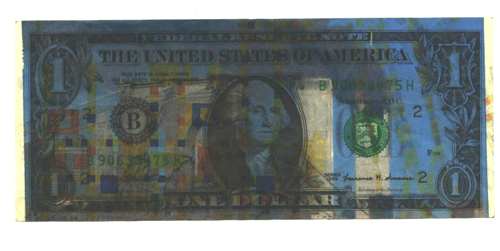>>MIRRORDOLLAR<<
>>DOLLARWORKS
CHRONOLOGY<<
>>BILLS BY OTHERS<<
Paper money is implicated in trade, wealth and survival across the gamut of contemporary human experience. Officially issued, bills pass from hand to hand, fueling trade and exchange, carrying transferable value. Their format and design allow portability and accumulation, imply authority and encourage social interaction and community. Currencies, as social instruments, are often bound to acceptance, credence and approval. In any culture, money talks.
The value of these official pieces of paper is vested in their physicality, inscribed with their worth and purpose. The printed note is an unchallenged territory, and, when its authenticity is questioned, the note bears its own evidence. We examine a dollar bill and face an institutional entity. Some people know about the Masonic symbolism of the pyramid and the eye. Most people take bills for granted; many don't even know the names of the portraits of historical male figures printed in some notes. There are no US bills with images of women.
Anyone paying bills electronically and using credit cards surely has an awareness of how the supply of circulating printed currency must be dwindling. And, removing notes from the pragmatic realm, what comes into our hands is a standard work of mass-produced engraving, including institutional and staid pictorial content. For many people, the dollar has lost much of its potential esthetic aura. In an age infused with high-impact graphic images, the dollar's actual form becomes more anachronic. In other countries, bills are fantastic esthetic vehicles. Here's advocating for artist-designed dollars!
Notes enter the public realm through a network of branches of the Federal Reserve System. As fragile objects in a disposable culture, at some point, notes reach the end of their cycle of circulation through wear and tear, rough handling and mishandling. Having accomplished their mission, notes are retired and recycled.
The Bureau of Engraving provides information on currency and sells a broad range of money permutations: from uncut sheets to shredded bills. Some collectors treasure bills with particular numerical coincidence (as in the Lucky money with a row of 88888) or other subjective meaning sequence, misprints, special editions, official stamping, souvenir signatures, odd designs and unusual markings.
Beyond the traditional and sanctioned areas, notes are also used in the culture as vehicles to transmit messages and ideas, express difference or add visibility to an issue or cause. Among the most able of vehicles, notes circulate from hand to hand, always ready to be converted into goods and services. When they carry messages, they enter into extra-official duty. Sometimes people will mark currency with their images, prayers, hopes, inspirational messages, and cries for help. At times, political activists stamp currency with their brand and messages or people express their protest, enhancing visibility and rallying support for their issues.
In the political culture, notes can often become vehicles of satire and social commentary. Repeatedly depicted in political cartoons, advertisements and image-statistics, bills have become potent polyvalent symbols. Even a pointed practice of American humor, the satirizing of the President, an extension of serious political caricature, finds expression through images of bills. This is one of the possible junctures —and escapes—of the bill from its functional purposes.

Wearing one's expensive shirt, like conspicuously spending one's new money is much better than not having or losing them. Being shirtless and moneyless are equally damned in all cultures. In America, it takes three generations to go from shirtsleeves to shirtsleeves.
go for a ride beyond time and space